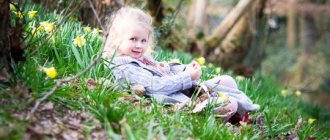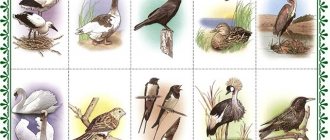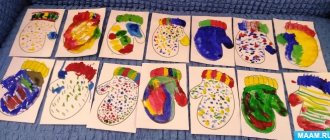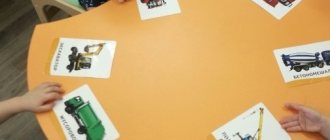Abstract of educational activities on cognitive development in the 2nd junior group on the topic “Transport”
Summary of GCD on cognitive development
in the 2nd junior group on the topic “Transport”
Target:
Systematize children's knowledge about transport.
Tasks:
- Educational:
consolidate children’s ideas about transport, that transport can be land, air, water; activate the words in children’s speech: passenger car, truck, names of car parts.
- Developmental:
develop thinking, memory and attention, teach you to solve riddles.
- Educational:
develop the ability to listen carefully to the teacher and the answers of other children.
Equipment:
visual and didactic material on the topic “Transport”, toys - transport, toy - bear, projector, presentation.
GCD move.
Knock on the door
Educator
: Who is this knocking on our door? I'll go have a look.
Behind the door is Pasha the bear
Educator:
Guys, look, a bear cub has come to visit us, his name is Pasha. Let's say hello to him
Children:
Hello, little bear Pasha.
Teddy bear:
Guys, I came to you from the forest, and on the way I saw a lot of incomprehensible things, something big and iron rode on 4 wheels. Tell me what it is?
Children:
Yes, sure!
Educator:
The guys and I know a lot of interesting things about what transport is, what it is like and what it is needed for, we will tell you everything now. Sit back and listen carefully. Guys, listen to the riddles and guess:
1. The light is on, the engine is humming
Tires on wheels
Dashing along the road
Us in itself (Machine)
Children's answers.
Educator:
Pasha, look, this is a car. Guys, tell me, what does the car have?
Children:
wheels, cabin, steering wheel, seat, headlights...
Educator:
Well done. What color is it?
Children:
…
Educator:
Right. Tell me, why do we need such a machine?
Children:
transport cargo or people.
Educator:
That's right, what kind of cargo can be transported on a truck?
Children:
sand, bricks, logs...
Educator: And to
is he driving the car?
Children:
Driver, chauffeur...
Educator:
Well done, you told everything correctly. Listen to the following riddle:
What kind of bird is this: it doesn’t sing songs,
Doesn't build nests, people or cargo
lucky (Airplane)
Children:
Educator:
That's right guys, this is an airplane, this is an air mode of transport. Why is it called that?
Children:….
Educator:
That's right, look, what parts does the plane consist of?
Children:
cockpit, wings, tail...
Educator:
Why do you need a plane?
Children:
Educator:
That's right, transport people and goods over long distances. Do you know who flies the plane?
Children:
Educator:
The plane is controlled by a pilot. Let's take a little rest...
FISMUTKA: “Truck”
a truck is carrying sand (they walk in a circle, pretending to be a steering wheel)
people are surprised: (they throw up their hands and make a surprised face)
like this a miracle - miracles (turn your head right - left)
there is sand in it under the sky (stretch on tiptoes, raising arms up).
Educator:
Well done guys, sit down on the chairs, let's tell little bear Pasha about one more transport. Listen to the riddle:
The palace floats on the waves,
People are lucky on themselves (Ship)
Children:
Educator:
That's right, is a ship a type of water transport? Why is it called that?
Children:
moves on water
Educator:
how can I use it?
Children:
transport people and cargo.
Educator: That's right, look what color our ship is?
Children:
Educator: Do you know who controls the ship?
Children:
Educator: That's right, the captain controls the ship. Well, Pasha, did you like it with us?
Little Bear Pasha: Yes, I liked it. Guys, I learned so many new things today, thank you very much, but it’s time for me to return to the forest.
Educator:
It's time for Pasha the bear cub to go home, let's take him?
Answers: Yes...
Educator: we get into our car and hit the road. We took the bear cub to the forest, and what did we introduce the bear cub to today?
Children:
With transport.
Educator:
That's right, did you like our meeting with the bear cub?
Children:
Yes!
Educator:
Let's go play with our transport.
Target:
- give children a basic understanding of transport, - promote the establishment of positive contact between children, - continue to develop the ability to actively take part in a conversation, answer the teacher’s questions,
Tasks:
- consolidate knowledge of the names of the professions of people who drive different types of transport;
- give a “countdown” performance 5, 4, 3, 2, 1; - activate children's vocabulary with words: transport, cyclist, driver, motorcyclist, driver, pilot, machinist, captain, astronaut, rocket, port, pier, water area; - continue to coordinate speech with movements; - preserve and strengthen the health of children by using health-saving technologies (active musical games) - continue to perform movements to the music clearly, rhythmically; respond to the beginning and ending of a musical phrase, - develop the ability to build from cubes of different types according to a pattern; Materials and equipment:
- pictures depicting: a bicycle, a motorcycle, a car, a bus, a ship, an airplane, a rocket made from cubes, a rocket - a magnetic board, - a music center, recordings of songs, games, the sound of a rocket taking off;
excerpt from the film about “Leopold the Cat” song ...flying around the world, Musical game “Machine” author. Konopelko, Musical game “Bus”, author. Zheleznova, Musical game “Here is our train coming...” Music. N. Metlova, lyrics. T. Babajan, an excerpt from their cartoon “At the Port”, the song “We came to the port today...” about ships, Musical game: “Airplane” Spanish. Chudariki, A. Rybnikova - “Meeting” from the film. “The Tale of the Starry Boy”), - a starry sky projector, - a multimedia installation for showing a cartoon, - pictures depicting all types of transport presented in the lesson (for each child) Preliminary work:
- observation of transport, - examination of albums, illustrations with images transport, reading works, guessing riddles, - conversations about traffic rules, pedestrian rules, - didactic, active, musical games, games with building materials
Progress of joint activities:
Guys, today we will be traveling! Today I didn’t just walk to work, I arrived by public transport! Guess what transport? It has two wheels AND a saddle on a frame. Children spin them with their feet.
: Bicycle
Educator
: That's right, well done!
(shows an illustration of a bicycle) Who controls the bicycle? (children's answers) Cyclist. And now you and I will go for a bike ride. (to the soundtrack of an excerpt from the song “Leopold the Cat” about a bicycle...flying around the world, children lying on their backs pretend to ride a bicycle) Teacher
: We’ve arrived. And now we will continue on our way to... This is a loud car
No steering wheel and no cabin. The guy in the helmet is very brave and handles it skillfully. Children
: -Motorcycle
Educator:
Correct!
Well done! Shows an illustration on an easel - Depict how a motorcycle hums: Trerr-trrr-trrr! Children pretend. Educator
: Who drives the motorcycle?
(motorcyclist - children's answers) Guess what kind of transport this is?
The light is on, the engine is humming There are tires on the wheels Along the road it dashes us inside...
Children
: Car
Teacher:
That's right!
Who is driving the car? (children's answers - driver) Start your engines, let's go further in cars Musical game "Car" auto. Konopelko Educator:
The house is walking down the street, everyone is lucky to get to work.
Not on chicken legs, in rubber boots Children
: bus
Teacher:
Well done!
Who drives the bus? (driver) Take your seats, we’ll continue on by bus (sit on chairs standing in two rows) Musical game “Bus” auth. Zheleznova Educator
: We've arrived!
Let's go out! What's rushing and hissing and knocking with wheels: Chuh-chukh-chukh-chu! I'm flying on rails! Children:
Train
Teacher:
That's right!
Who controls the train? (children's answers - driver) Let's continue our journey by train! Take your seats in the carriages (children stand one after another) Musical game “Here is our train coming...” Music. N. Metlova, lyrics. T. Babajan Educator
: Where have we gone, what type of transport will we see here?
A huge house is floating on the sea - It carries people on itself through the waves Children:
Ship
Educator
: let's look at the ships
Watching an excerpt from their cartoon “In the port” the song “We came to the port today...” about ships Educator
: what is the song about?
(children's answers) Next riddle:
Boldly floats in the sky, overtaking the birds in flight.
Man controls it. What's happened? Children: Airplane Teacher: Well done! Who flies the plane? (answers from child pilots) We also turn into pilots and fly airplanes! Musical game: "Airplane" Spanish. Chudariki Educator:
In the sky, a blue-blue star sparkles.
I’ll definitely check if there are people on Venus? To an amazing planet I will fly on... Children
: Rocket
Teacher:
That's right!
Who controls the rocket? (answers from children - astronaut) Let's build a Rocket (there are cubes and an illustration with a sample of a rocket on the side), what can we build a rocket from? (children's answers) Let's start construction! I suggest you sit comfortably in our “rocket” - We are going on a space journey! Children lie down on the sun-shaped carpet, the teacher begins the countdown, inviting the children to repeat 5, 4, 3, 2, 1 - start! (sound of a rocket) Calm music sounds (A. Rybnikov - “Meeting” from the film “The Tale of the Star Boy”), the children look at the ceiling with a projection of the rotating starry sky... -
Look how high, mysterious the sky is (the teacher speaks smoothly in an even voice, with short stops) It can only be seen when the sun sets and there are no clouds in the sky.
The whole sky is strewn with stars and constellations, they have different names: Ursa Major, the constellation Gemini, Aquarius, Leo, Scorpio, Pisces, etc. ... (music ends) Well, our journey has ended. We're flying back to kindergarten! I start the countdown: I invite the children to repeat 5, 4, 3, 2, 1 - start! (sound of a rocket) The guys get up. Activity reflection: Educator:
We are in kindergarten again! - Guys, what did we do today? (travelled) - What did we travel on? (children's answers). — What do you remember most? (children's answers) - Was it difficult for you to do something? (children's answers) - Today you were very active, attentive, and answered questions correctly! As a souvenir, I give you cards with images of the transport we traveled on!
Summary of a lesson on speech development in the second junior group of the kindergarten "Transport"
Summary of a lesson on speech development in the second junior group of the kindergarten "Transport"
Program content:
Teach children to identify and distinguish between transport and types of transport, identify the main features (color, shape, size, structure, functions, etc.), develop coherent speech and the ability to answer questions.
Material:
Pictures of an airplane, car, bus, etc.; flannelograph, toys - airplane, car, bus.
Progress of the lesson: Kitty (a child from the preparatory group for school in a cat costume) comes to visit the children. The cat came with gifts: he brought riddles and object pictures. Educator. Our cat loves to ask riddles. Try to guess them. Kitty. Doesn't fly, doesn't buzz, the beetle runs down the street. And they burn in the beetle's eyes. Two shiny lights. (Car) The teacher invites the children to find the answer among the object pictures laid out in front of them and pick up the desired picture. Children find the answer; one child puts a picture of a car on a flannelgraph. The cat asks the following riddle: What a miracle this blue house is. There are a lot of kids in it. Wears rubber shoes and eats gasoline. (Bus) The teacher invites the children to find the answer and pick up the desired picture. Children find the answer; one child puts a picture of a bus on a flannelgraph. The cat asks the following riddle: Swims boldly in the sky, outrunning the birds in flight. Man controls it. What is this? (Airplane)
The teacher invites the children to find the answer and pick up the desired picture. Children find the answer; one child puts a picture of an airplane on a flannelgraph.
Didactic game “Show and name”
The teacher shows pictures depicting types of transport, clarifies their components and purpose. Then he gives each child a picture depicting one type of transport and explains the rules of the game.
Educator. I will talk about a car, bus, plane, etc. If this vehicle is in your picture, pick it up and name it.
Game: “What we hear, we will repeat”
Educator. The streets are noisy from traffic. Let's remember and name the sounds that we hear.
The car tires rustle on the road: Sh – Sh – Sh
The pilot starts the airplane engine: R – R – R
The plane flew: U - U - U
They start the motorcycle and it crackles louder and faster: D – D – D – D – D
A train passes by: Chukh - Chukh - Chukh
Physical school
A plane flies by, and I’m about to take off with it. (Children look up and follow the flying plane with their fingers.)
He pulled back the right wing and looked,
He took the left wing back and took a look. (They move their hands up alternately and follow with their gaze)
I start the engine and look carefully. (Make rotational movements in front of the chest)
I rise up, I fly, I don’t want to return. (Stand on tiptoes and perform a flying movement).
The cat and the teacher invite the children to tell them about a car, a bus, an airplane, but first, Kitty asks the children to listen to how he can talk about transport: “This is a bus, it’s blue, it has wheels, a cabin, windows, doors, the driver drives the bus.” Then each child talks about their favorite modes of transport. The cat and the teacher praise the children and give them pictures of transport (the children are allowed to take the pictures home). Now let's play.
Outdoor game "Cars"
Each player gets a steering wheel. A column of cars leaves the garage one by one. The teacher raises the green circle and says: “Let's go!”, and all the children scatter throughout the hall so as not to touch each other. Raises a yellow circle - children start walking, red - they must stop. The teacher notes the most dexterous children who skillfully performed walking and running in different directions.
Educator - What great fellows you are! You turned out to be very good, and most importantly, smart machines. Now I am sure that you will not get into any trouble on the road!
Summary of a lesson on speech development in the second junior group of the kindergarten "Transport"
Program content:
Teach children to identify and distinguish between transport and types of transport, identify the main features (color, shape, size, structure, functions, etc.), develop coherent speech and the ability to answer questions.
Material:
Pictures of an airplane, car, bus, etc.; flannelograph, toys - airplane, car, bus.
Progress of the lesson: Kitty (a child from the preparatory group for school in a cat costume) comes to visit the children. The cat came with gifts: he brought riddles and object pictures. Educator. Our cat loves to ask riddles. Try to guess them. Kitty. Doesn't fly, doesn't buzz, the beetle runs down the street. And they burn in the beetle's eyes. Two shiny lights. (Car) The teacher invites the children to find the answer among the object pictures laid out in front of them and pick up the desired picture. Children find the answer; one child puts a picture of a car on a flannelgraph. The cat asks the following riddle: What a miracle this blue house is. There are a lot of kids in it. Wears rubber shoes and eats gasoline. (Bus) The teacher invites the children to find the answer and pick up the desired picture. Children find the answer; one child puts a picture of a bus on a flannelgraph. The cat asks the following riddle: Swims boldly in the sky, outrunning the birds in flight. Man controls it. What is this? (Airplane)
The teacher invites the children to find the answer and pick up the desired picture. Children find the answer; one child puts a picture of an airplane on a flannelgraph.
Didactic game “Show and name”
The teacher shows pictures depicting types of transport, clarifies their components and purpose. Then he gives each child a picture depicting one type of transport and explains the rules of the game.
Educator. I will talk about a car, bus, plane, etc. If this vehicle is in your picture, pick it up and name it.
Game: “What we hear, we will repeat”
Educator. The streets are noisy from traffic. Let's remember and name the sounds that we hear.
The car tires rustle on the road: Sh – Sh – Sh
The pilot starts the airplane engine: R – R – R
The plane flew: U - U - U
They start the motorcycle and it crackles louder and faster: D – D – D – D – D
A train passes by: Chukh - Chukh - Chukh
Physical school
A plane flies by, and I’m about to take off with it. (Children look up and follow the flying plane with their fingers.)
He pulled back the right wing and looked,
He took the left wing back and took a look. (They move their hands up alternately and follow with their gaze)
I start the engine and look carefully. (Make rotational movements in front of the chest)
I rise up, I fly, I don’t want to return. (Stand on tiptoes and perform a flying movement).
The cat and the teacher invite the children to tell them about a car, a bus, an airplane, but first, Kitty asks the children to listen to how he can talk about transport: “This is a bus, it’s blue, it has wheels, a cabin, windows, doors, the driver drives the bus.” Then each child talks about their favorite modes of transport. The cat and the teacher praise the children and give them pictures of transport (the children are allowed to take the pictures home). Now let's play.
Outdoor game "Cars"
Each player gets a steering wheel. A column of cars leaves the garage one by one. The teacher raises the green circle and says: “Let's go!”, and all the children scatter throughout the hall so as not to touch each other. Raises a yellow circle - children start walking, red - they must stop. The teacher notes the most dexterous children who skillfully performed walking and running in different directions.
Educator - What great fellows you are! You turned out to be very good, and most importantly, smart machines. Now I am sure that you will not get into any trouble on the road!




